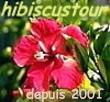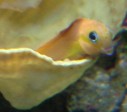-

"hibiscustour", three separate sites -
Islands and lagoons New Caledonia, Polynesia (part). -

Curiosity. Things, amazing, science, society.. -

Ideas perso. Household, Practical life, D.I.Y, Computering..
 
but reality |
  |
|
Magnificent colours of the tropical marine animals are not really made for humans's pleasure ; they devours each other as much as elsewhere, if not more. Better to know their weapons, sometimes very frightening ! see risks and dangers. Fish, tropical or not have stunning abilities You will be able to observe the life of the lagoon at the aquarium of Nouméa known around the world. |
 Our planet: coral reefs
shelter 4000 fish species. A film like “Nemo”, innocent and so
distracting, has increased the clown
fish capture considerably, with the losses which
one knows.
Fish of decoration are in process of extermination in
certain reefs, often for a very provisional egoistic
pleasure. Her
Our planet: coral reefs
shelter 4000 fish species. A film like “Nemo”, innocent and so
distracting, has increased the clown
fish capture considerably, with the losses which
one knows.
Fish of decoration are in process of extermination in
certain reefs, often for a very provisional egoistic
pleasure. Her e is another aspect of the ecology which is not approached, the
derision of the animal world: it is also the contempt of all that surrounds us,
that both makes us live and charms
us.
e is another aspect of the ecology which is not approached, the
derision of the animal world: it is also the contempt of all that surrounds us,
that both makes us live and charms
us.
2/3 of edible fish have disappeared from the oceans. 200
million sharks die each year, only for their tail and
their fins.
|
Triggerfish Fishes of
the coral reefs are generally short and flat: not shaped for
long journey, they can accelerate highly and disappear when
diving ! where does could they have been ??
|
The parrot fish Can nibble the corals with its beak.
|
The troca was with its beautiful mother-of-pearl to finish in buttons of shirt; less, but always exploited. |
|
" radio " fish. No, it does not emit waves !
|
|
|
|
|
|
|
|
|
|
|
|
|
| In
Nouméa,
amid a pretigious settingd.
the
aquarium of lagoons
+
(2007).
In a themes
park,
it is a comprehensibe view of the whole hydro-eco-system
of the New Caledonia which is offered to the vistor.
The visit follows a way
starting from the mountains, the rivers and arriving on the
coast, its mangroves, then the
lagoon and the reefs. Both a very original an vocational program. Promenade Roger Laroque. |
 Behind the screen of the computer, we can read videos, make a virtual visit with some stops at pools along with audio comments that are starting with a single click. |
![]() vie du lagon 2 (origin, sea, depth, madreporia, corals and madreporia, tentacles..)
vie du lagon 2 (origin, sea, depth, madreporia, corals and madreporia, tentacles..)
The lagoon (origin and formation, kind of reefs, passes, islets/motus)
Lagoon life 1 (fish and reef vivid beings)
Lagoon life 2 next (fish and reef vivid beings)
Lagoon life 3 next ( reef vivid beings, unsafe fish and other animals)
